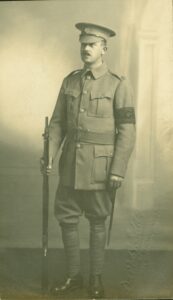Bexhill’s First World War Home Guard
The origins of the Bexhill unit came from earlier attempts by Earl De La Warr to form a Home Defence Corps. Mr R W Robbins instigated steps by the Commercial Association to form a Volunteer Training Corps which took form in November 1914. Amongst the first instructors were; Captain F S Wise of the Fire Brigade, Mr Stearns and Mr Duncan, both professors of physical training.
Other early members were Percy Webber, Colonels H D Cutbill and H F K Waldron and Major Boys. Stalwarts were Lieutenants J R de Lannoy, H T Shaw, A F Bryan and A G Wells.![B Company [Bexhill] 2nd Volunteer Battalion Chronicle 1918 14 Dec](https://www.bexhillmuseum.org.uk/wp-content/uploads/2014/02/B-Company-Bexhill-2nd-Volunteer-Battalion-Chronicle-1918-14-Dec-300x206.jpg)
There was little official support. Uniforms and equipment were privately purchased from a fund of £200 raised locally. Many members provided their own uniforms. The first officially approved uniform made its appearance in June 1915 in light grey with a red armband bearing the letters GR. During this month the unit along with the Lowther’s Lambs acted as the defending force in a night attack exercise by troops from Hastings.
In January 1916 the unit did a 20 mile route march to Herstmonceux and back. The following October the unit became the 4th Battalion of the Sussex Volunteer Regiment. Commanded by Captain H de B C Garfit, the Battalion was praised as being the most efficient in the kingdom.
The Battalion’s B Company was comprised of Bexhill men. Non Commissioned Offers were Company Sergeant Major Robbins and Company Quartermaster Sergeant Sim and Sergeant H S Kortright. A list of those serving during August 1916 was published in the Bexhill Chronicle of 12th August 1916.
Being a Volunteer required commitment. Route marches, parades, instruction and drills. The minimum expectation was that a Volunteer would achieve 30 drills every three months. There was a full programme involving several parades a week and 2 drills per week. There would also be the occasional camp. The camp at Eastbourne in 1917 was complete with ample foodstuffs provided in response to an appeal in the Bexhill Chronicle.

Entrenching practice was undertaken at the Turkey Road brickyards, the Volunteers having already constructed trenches at Sidley, West Bexhill and the Park extension [The Polegrove]. It is possible the trenches constructed at West Bexhill were taken over, and added to, by the Canadian Trench Warfare School.
In 1918 there was a machine gun section under Corporal A Deeprose. In the July of that year the 4th Battalion Sussex Volunteer Regiment became the 2nd Volunteer Battalion Royal Sussex Regiment. B Company maintaining its Bexhill identity. In October the final parade took place at the drill hall with 30 of the 80 serving present. This was followed in December 1918 by a dinner at the Devonshire Hotel. 500 men had passed through the ranks. Of those going into army service, two had received decorations and three volunteers, Messrs Jewhurst, Morley and Prior, had died on active service.
Formal disbandment took place in October 1919. Over a quarter of a million men had served with the Volunteers, some of them in their 60s and 70s.
Other Articles in this section:

